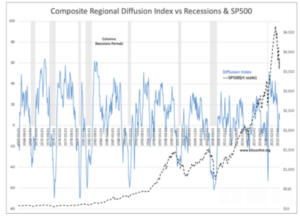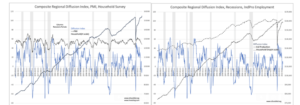“Davidson” submits:
The Philly and Chicago Fed have the longest reporting series and form the diffusion composite. This composite, on which many rely, for economic signals, is compared with other frequently used long-term indicators, PMI(Purchasing Managers Index), Recession periods, the Household Survey(employment),Industrial Production and the SP500 Index. This comparison is revealing not only in how the majority of investors perceive market risk but also how does the Federal Reserve.
Investors should always seek to buy low and sell dear. Many, however, find it impossible to buy when the overwhelming consensus it pessimistic and fear criticism by those with short-term perspectives. Buying during periods of high market pessimism with risk adverse investment boards carries career risk if one is one quarter too early. Buying too early when sources deemed authoritative indicate increased threat from a deepening economic downturn is viewed as career suicide. The Regional Fed Business Activity Indices, the PMI and even the SP500, especially when highly volatile, have frequently forced withdrawal from equities time after time.
The history shown in these charts makes it clear that the best opportunities occur during highest levels of pessimism. That the PMI, the Fed Diffusion Indices, and the SP500 are highly correlated derives from the fact that they are market sentiment not economic indicators. Recession periods, Household Survey and Industrial Production which are correlated as a group are economic indicators and poorly correlated with the former. It is when sentiment diverges from economics that investment opportunity occurs. The wider the divide, the greater the potential for return. Today is very similar to past advantageous opportunities to buy equities. One of the more frequently quoted “authoritative indicators” is the PMI. It is in quotes because while many swear by this indicator it has indicated “authoritatively” 27 recessions in the history shown when there have been only 9 recession periods. That the Fed indices correlate similarly reveals that this index is equally sensitive to sentiment. In my perspective, that the Fed decision-making is so dependent on market sentiment is a disappointing assessment of their critical thinking.

Sentiment indicators remain about as pessimistic as the 55+yr historical record. The current environment remains, in my perspective with rising employment, as good and perhaps even better a time to invest in equities as we have had the last half-century.
